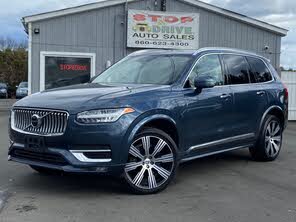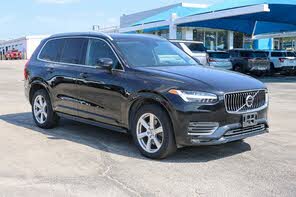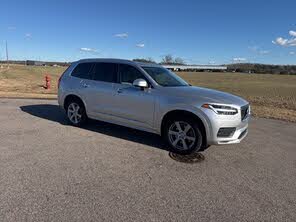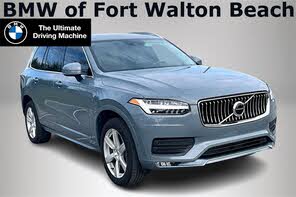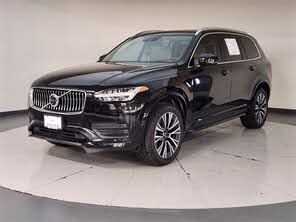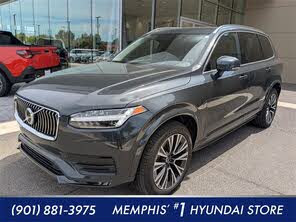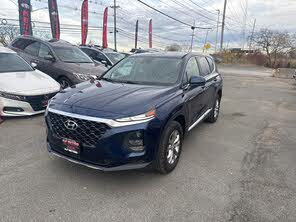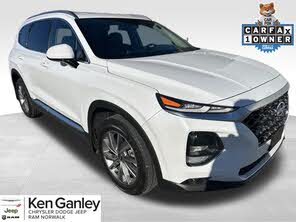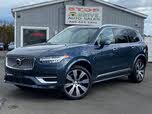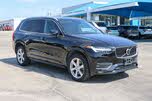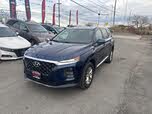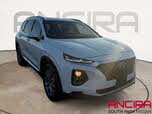2021 Volvo XC90 vs 2020 Hyundai Santa Fe
Overview | |
MSRP$26,275 | MSRP$49,000 |
Listings1155 | Listings338 |
Ratings & Reviews | |
User Reviews | User Reviews |
Expert reviews8.8 out of 10 | Expert reviews7.7 out of 10 |
Pros
Cons
| Pros
Cons
|
2020 Hyundai Santa Fe Reviews SummaryLast year, Hyundai changed its approach to the Santa Fe. The smaller five-passenger Santa Fe Sport got drop-kicked from the automaker’s lineup, replaced by this completely redesigned version of the SUV. The larger seven-passenger Santa Fe got a new name for one year (Santa Fe XL), and then the all-new 2020 Hyundai Palisade replaced that vehicle. With the Palisade’s arrival, there is just one Santa Fe for 2020, a five-passenger crossover that resides in a sweet spot between traditional compact and midsize models. It gets several updates, too, including a standard rear-seat reminder system, an available camera-based Blind-Spot View Monitor system, and new design accents to better distinguish the top trim level. | |
2021 Volvo XC90 Reviews SummaryVolvo may be known for sensible station wagons, but the XC90 SUV is the Swedish automaker’s de facto flagship. The current generation debuted design features, technology, and powertrains that have since found their way into most other Volvo models. Several years into the current-generation model’s lifecycle, the XC90 is no longer a trendsetter, but remains Volvo’s contender in the competitive midsize luxury SUV segment, with the automaker’s typical emphasis on safety features. The current-generation XC90 launched for the 2016 model year, so most competitors—including the Audi Q7, Acura MDX, BMW X5, and Mercedes-Benz GLE-Class—have been updated or redesigned since then. The Cadillac XT6 and Lincoln Aviator didn’t even exist when this generation of XC90 launched. A redesigned version is expected to arrive soon, so changes to the 2021 XC90 are minimal. All 2021 Volvo models are now limited to 112 mph for safety reasons and get Care Key, which lets owners limit the top speed before loaning the car out to a friend or family member. The XC90 also gets a handful of newly standard tech features, and some small cosmetic changes. Volvo offers the XC90 in three trim levels—Momentum, R-Design, and Inscription—with three powertrain options: T5 and T6 gasoline engines, and the T8 plug-in hybrid. Our test car was a range-topping T8 Recharge Inscription, combining the top Inscription trim level with the plug-in hybrid powertrain, which has the highest output of the three. | |
No video found | |
Popular Features & Specs | |
Engine2.4L 185 hp I4 | Engine2.0L 250 hp I4 |
Drive TrainFWD | Drive TrainFWD |
Seating Capacity5 | Seating Capacity7 |
Horsepower185 hp @ 6000 rpm | Horsepower250 hp @ 5500 rpm |
MPG City22 | MPG City21 |
MPG Highway29 | MPG Highway30 |
Engine | |
Engine Name2.4L 185 hp I4 | Engine Name2.0L 250 hp I4 |
Torque178 lb-ft @ 4000 rpm | Torque258 lb-ft @ 1500 rpm |
Horsepower185 hp @ 6000 rpm | Horsepower250 hp @ 5500 rpm |
DrivetrainFWD | DrivetrainFWD |
Fuel Economy | |
MPG City22 | MPG City21 |
MPG Highway29 | MPG Highway30 |
Interior | |
Seating Capacity5 | Seating Capacity7 |
Key Features | |
Sunroof/Moonroof | Sunroof/MoonroofStandard |
Safety | |
Front Crash Overall4 | Front Crash Overall5 |
Side Crash Overall5 | Side Crash Overall5 |
Dimensions & Capacity | |
Cargo Space35.9 cu ft | Cargo Space10.7 cu ft |
Curb Weight3591 lbs | Curb Weight4374 lbs |
Height66.1 in | Height69.9 in |
Length187.8 in | Length195.0 in |
Width74.4 in | Width84.3 in |
Wheelbase108.9 in | Wheelbase117.5 in |
Maximum Payload1138 lbs | Maximum Payload1631 lbs |
Number of doors4 | Number of doors4 |
Maximum Towing Capacity2000 lbs | Maximum Towing Capacity4000 lbs |
Overview | ||
MSRP | $26,275 | $49,000 |
Listings | ||
Ratings & Reviews | ||
User reviews | ||
Expert reviews | 8.8 out of 10Read full review | 7.7 out of 10Read full review |
Pros & cons | Pros
Cons
| Pros
Cons
|
Summary | Last year, Hyundai changed its approach to the Santa Fe. The smaller five-passenger Santa Fe Sport got drop-kicked from the automaker’s lineup, replaced by this completely redesigned version of the SUV. The larger seven-passenger Santa Fe got a new name for one year (Santa Fe XL), and then the all-new 2020 Hyundai Palisade replaced that vehicle. With the Palisade’s arrival, there is just one Santa Fe for 2020, a five-passenger crossover that resides in a sweet spot between traditional compact and midsize models. It gets several updates, too, including a standard rear-seat reminder system, an available camera-based Blind-Spot View Monitor system, and new design accents to better distinguish the top trim level. | Volvo may be known for sensible station wagons, but the XC90 SUV is the Swedish automaker’s de facto flagship. The current generation debuted design features, technology, and powertrains that have since found their way into most other Volvo models. Several years into the current-generation model’s lifecycle, the XC90 is no longer a trendsetter, but remains Volvo’s contender in the competitive midsize luxury SUV segment, with the automaker’s typical emphasis on safety features. The current-generation XC90 launched for the 2016 model year, so most competitors—including the Audi Q7, Acura MDX, BMW X5, and Mercedes-Benz GLE-Class—have been updated or redesigned since then. The Cadillac XT6 and Lincoln Aviator didn’t even exist when this generation of XC90 launched. A redesigned version is expected to arrive soon, so changes to the 2021 XC90 are minimal. All 2021 Volvo models are now limited to 112 mph for safety reasons and get Care Key, which lets owners limit the top speed before loaning the car out to a friend or family member. The XC90 also gets a handful of newly standard tech features, and some small cosmetic changes. Volvo offers the XC90 in three trim levels—Momentum, R-Design, and Inscription—with three powertrain options: T5 and T6 gasoline engines, and the T8 plug-in hybrid. Our test car was a range-topping T8 Recharge Inscription, combining the top Inscription trim level with the plug-in hybrid powertrain, which has the highest output of the three. |
Video | No video found | |
Popular Features & Specs | ||
Engine | 2.4L 185 hp I4 | 2.0L 250 hp I4 |
Drive Train | FWD | FWD |
Seating Capacity | 5 | 7 |
Horsepower | 185 hp @ 6000 rpm | 250 hp @ 5500 rpm |
MPG City | 22 | 21 |
MPG Highway | 29 | 30 |
Engine | ||
Engine Name | 2.4L 185 hp I4 | 2.0L 250 hp I4 |
Torque | 178 lb-ft @ 4000 rpm | 258 lb-ft @ 1500 rpm |
Horsepower | 185 hp @ 6000 rpm | 250 hp @ 5500 rpm |
Drivetrain | FWD | FWD |
Fuel Economy | ||
MPG City | 22 | 21 |
MPG Highway | 29 | 30 |
Interior | ||
Seating Capacity | 5 | 7 |
Key Features | ||
Sunroof/Moonroof | Standard | |
Safety | ||
Front Crash Overall | 4 | 5 |
Side Crash Overall | 5 | 5 |
Dimensions & Capacity | ||
Cargo Space | 35.9 cu ft | 10.7 cu ft |
Curb Weight | 3591 lbs | 4374 lbs |
Height | 66.1 in | 69.9 in |
Length | 187.8 in | 195.0 in |
Width | 74.4 in | 84.3 in |
Wheelbase | 108.9 in | 117.5 in |
Maximum Payload | 1138 lbs | 1631 lbs |
Number of doors | 4 | 4 |
Maximum Towing Capacity | 2000 lbs | 4000 lbs |
When consumers explored the 2020 Hyundai Santa Fe, they were met with a bold and distinctive design offering three trim levels: SE, SEL, and Limited. Those opting for a “2.0T” model received a turbocharged engine that elevated both power and performance. All-wheel drive (AWD) was available as an option, providing enhanced traction by distributing power from front to rear wheels as needed. Shoppers had choices including paint colors, interior upholsteries, and additional dealer-installed accessories. The Limited 2.0T trim in our test, for instance, came in at $39,170, inclusive of floor mats.
Hyundai’s approach to the Santa Fe’s aesthetics was avant-garde. This SUV showcased a grille shape, stacked lighting elements, asymmetrical fender stampings, unique wheel well shapes, and an oversized rear “skid plate” that certainly grabbed attention. Inside, this sense of drama continued with a dual-cowl dashboard, diamond-textured speaker grilles, and a distinctive flecked headliner pattern. However, materials fell short, with glossy plastics and somewhat stiff leather seats, despite its impressive build quality and refined controls.
In comparison, the 2021 Volvo XC90 offered a more sophisticated take on SUV design. Introduced as a 2016 model, it brought a more modern flair to Volvo’s traditionally conservative style. Maintaining a boxy profile and a rectangular grille, Volvo added softer lines, more chrome, and iconic “Thor’s Hammer” LED headlights to deliver a fresh yet recognizable look.
Our Inscription test car, sporting extra chrome trim and optional 21-inch alloy wheels, was the pinnacle of XC90 trims in terms of flashiness. The R-Design variant went for a sportier appeal with 20-inch wheels, while the base Momentum model featured 19-inch wheels. Configured as a car-based crossover, the XC90 shared its SPA platform with other Volvo models, ensuring a consistent design language across the brand.
Inside, the XC90 took the route of Swedish minimalism, offering high-quality materials like matte-finish wood trim and unique options such as wool upholstery. This understated elegance was complemented by thoughtful arrangements and a luxurious Orrefors crystal shifter in our test vehicle.











For the 2020 Hyundai Santa Fe, skipping the base 185-horsepower 2.4-liter engine for the turbocharged 2.0-liter option was a wise choice. The latter delivered 235 hp and 260 lb-ft of torque between 1,450 rpm and 3,500 rpm, significantly outperforming the base engine. An eight-speed automatic transmission managed power distribution to the front wheels, although AWD was available, which eradicated the torque steer experienced with FWD models.
The Santa Fe was compliant and quick, offering a smooth ride, decent handling, and refined controls. Fuel economy was decent, with the EPA estimating 23 mpg combined for the 2.0T FWD model, and our test returned 22.1 mpg. The SUV also excelled in moderate off-roading conditions, but it was more of a reliable daily driver than a vehicle inviting adventurous off-road expeditions.
The 2021 Volvo XC90, on the other hand, boasted three powertrain options, all centered around a 2.0-liter four-cylinder engine paired with an eight-speed automatic transmission. The base T5 was turbocharged, producing 250 hp and 258 lb-ft of torque. The T6 variant added a supercharger, enhancing output to 316 hp and 295 lb-ft. The T8 Twin Engine plug-in hybrid was the most powerful, combining the T6 engine with electric motors to offer 400 hp and 472 lb-ft of torque.
While the T8 provided ample power, it struggled with smooth acceleration solely on electric power, often requiring gasoline engine support. The XC90 struck a balance between luxury and performance with an optional air-suspension system offering excellent ride quality and controlled body roll. However, the plug-in hybrid model excelled more in efficiency settings than outright power delivery. Towing capacities for most XC90 models were respectable at 5,000 pounds, though the T5 FWD was rated at 4,000 pounds.
The 2020 Hyundai Santa Fe was equipped to meet the diverse needs of American families with thoughtful storage solutions and five-passenger seating. The test vehicle featured heated, ventilated front seats with adjustable lumbar support and an extending thigh support, making long trips comfortable. The back seats offered ample space with features like rear air conditioning vents, sunshades, and reclining seats.
However, cargo space was where the Santa Fe slightly stumbled. Offering 35.9 cubic feet behind the rear seats and up to 71.3 cubic feet with seats down, it was adequate but not superior to other midsize SUVs. Additional storage compartments under the cargo floor provided some compensation. Hyundai’s hands-free liftgate also added convenience.
In terms of capacity, the 2021 Volvo XC90 took a different approach with its three-row seating available in six or seven-seat configurations. Headroom and legroom were average, with the third-row seating being less comfortable for adults. Despite these constraints, the XC90 impressed with a standard four-zone climate control system and an optional power moonroof that enhanced the spacious feel.
Cargo space in the XC90 lagged behind its competitors, especially in the T8 Recharge model, which offered just 11.2 cubic feet with all seats in place, 34.1 cubic feet with the rear seats down, and 64.1 cubic feet with both rear rows folded. The hands-free power tailgate was a useful feature, though.
Hyundai’s infotainment system in the 2020 Santa Fe was user-friendly and well-positioned. It featured stereo control knobs, main menu shortcut buttons, and customization options. With Bluetooth, Apple CarPlay, and Android Auto across all trims, the system also included extras like SiriusXM satellite radio and Blue Link connected services in higher trims. Limited models featured an 8-inch display, navigation, a surround-view camera, and a 12-speaker Infinity sound system. The head-up display and sophisticated voice recognition system further distinguished the Santa Fe’s tech offerings.
In contrast, the 2021 Volvo XC90’s Sensus infotainment system was streamlined and efficient, eschewing numerous physical buttons in favor of a 9-inch touchscreen. The system featured Apple CarPlay, Android Auto, Bluetooth, and a built-in WiFi hotspot as standard. Our test model even included a 19-speaker Bowers & Wilkins audio system and an optional head-up display. Despite the intuitive design, the text-heavy menus were somewhat challenging to read while driving, and the newly added wireless charging pad had compatibility issues with some phones.
The 2020 Hyundai Santa Fe was a strong contender in safety, boasting a five-star overall crash-test rating from NHTSA and a Top Safety Pick rating from IIHS. Standard features encompassed adaptive cruise control, forward collision warning, automatic emergency braking, lane-keeping assistance, and a rear-seat reminder system. Higher trims offered blind-spot and rear cross-traffic warning systems, a blind-spot view monitor, and an ultrasonic occupant alert system connected to its Blue Link app, providing multiple layers of protection for occupants.
Matching Hyundai’s safety rigor, the 2021 Volvo XC90 received a Top Safety Pick+ rating from IIHS (for non-hybrid models) and a five-star overall rating from NHTSA. Volvo included numerous advanced safety features as standard, including lane-keep assist, a driver-attention monitor, traffic-sign recognition, blind-spot monitoring, rear cross-traffic alert, and automatic emergency braking. The Pilot Assist system, combining adaptive cruise control with automated lane centering, was also a standout feature, though still dependent on an attentive driver.
CarGurus highlights

According to CarGurus experts, the overall rating for the 2020 Hyundai Santa Fe was 8.8 out of 10, whereas the 2021 Volvo XC90 scored a 7.7 out of 10. Despite the XC90’s luxurious appeal and the comprehensive safety package, the Santa Fe excelled with its robust safety features, innovative technology, and comfortable interior, all at a competitive price. For these reasons, the 2020 Hyundai Santa Fe stands out as the better choice for families seeking a well-rounded, safe, and feature-rich SUV.
Choose the 2021 Volvo XC90 if:
- You appreciate a blend of modern luxury with traditional design elements.
- You prefer an interior marked by understated, high-quality materials and minimalist design.
- You seek an SUV with robust standard safety features and advanced driver-assistance systems.
Choose the 2020 Hyundai Santa Fe if:
- You value bold, distinctive design and don't mind standing out.
- You prefer a family SUV with thoughtful amenity offerings and comfortable seating.
- You are impressed by an extensive standard safety suite and innovative safety features.
CarGurus highlights

According to CarGurus experts, the overall rating for the 2020 Hyundai Santa Fe was 8.8 out of 10, whereas the 2021 Volvo XC90 scored a 7.7 out of 10. Despite the XC90’s luxurious appeal and the comprehensive safety package, the Santa Fe excelled with its robust safety features, innovative technology, and comfortable interior, all at a competitive price. For these reasons, the 2020 Hyundai Santa Fe stands out as the better choice for families seeking a well-rounded, safe, and feature-rich SUV.
Choose the 2021 Volvo XC90 if:
Shop Now- You appreciate a blend of modern luxury with traditional design elements.
- You prefer an interior marked by understated, high-quality materials and minimalist design.
- You seek an SUV with robust standard safety features and advanced driver-assistance systems.
Choose the 2020 Hyundai Santa Fe if:
Shop Now- You value bold, distinctive design and don't mind standing out.
- You prefer a family SUV with thoughtful amenity offerings and comfortable seating.
- You are impressed by an extensive standard safety suite and innovative safety features.

By: CarGurus + AI
At CarGurus, our team of experienced automotive writers remain at the heart of our content operation, conducting hands-on car tests and writing insightful guides that are backed by years of industry experience. To complement this, we are harnessing AI to make our content offering more diverse and more helpful to shoppers than ever. To achieve this, our AI systems are based exclusively on CarGurus content, ratings and data, so that what we produce is both unique to CarGurus, and uniquely helpful to car shoppers.


